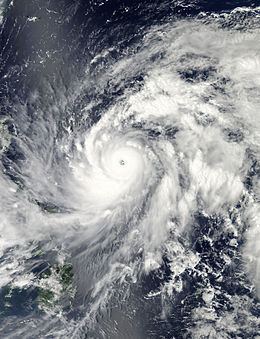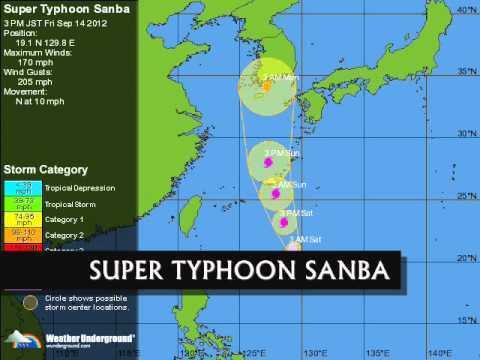Formed September 10, 2012 Fatalities 6 total Category Category 5 Super Typhoon | Dissipated September 19, 2012 Highest wind speed 205 km/h | |
Highest winds 10-minute sustained: 205 km/h (125 mph)1-minute sustained: 285 km/h (180 mph) Lowest pressure 900 hPa (mbar); 26.58 inHg Damage $378.8 million (2012 USD) Date 10 September 2012 – 17 September 2012 Similar Typhoon Bolaven, Typhoon Tembin, Typhoon Maemi, Typhoon Jelawat, Typhoon Guchol | ||
Typhoon Sanba, known in the Philippines as Typhoon Karen, was the strongest tropical cyclone worldwide in 2012. The sixteenth named storm and tenth typhoon of the annual typhoon season, Sanba formed as a tropical depression east of The Philippines on September 10. The storm gradually intensified as it moved generally northward in an area favorable for tropical development. The system was soon upgraded to a tropical storm less than a day after formation and subsequently further to a typhoon on September 12. Later that day, Sanba entered a phase of explosive intensification, quickly strengthening and gaining annular characteristics. On September 13, the system attained its peak intensity with maximum sustained winds of 125 mph (205 km/h), and a barometric pressure of 900 mbar (hPa; 26.58 inHg), becoming the strongest typhoon in the Western Pacific Ocean since Megi in 2010. Accelerating towards more northerly latitudes, a period of gradual weakening ensued afterwards as its eye expanded. It made landfall on South Korea late on September 17 as a typhoon before transitioning into an extratropical cyclone the following day. Sanba's remnants tracked into the Primorsky Krai region of eastern Russia before they were last noted on September 19.
Contents

Passing just to the west of Japan, Sanba caused extensive losses to agriculture, forestry, and fishing industries on the islands of Okinawa Prefecture. Further inland on Kōchi and Gifu Prefectures, heavy rains damaged agricultural regions and washed out numerous roads. Losses on both prefectures totalled to ¥1.55 billion (US$1.98 million). Upon its landfall on the Korean Peninsula on September 17, it became the first time in 50 years that the peninsula had been struck by at least four typhoons in a single year. In South Korea, torrential rainfall also washed out road systems and inundated crop land, as well as damaged infrastructure. Losses there associated with Sanba totaled to ₩389 billion (US$347.5 million). In North Korea, the heavy precipitation worsened preexisting flood conditions initially started by Tropical Storm Khanun two months prior. Overall, throughout the typhoon's nine-day trek, Sanba caused US$378.8 million in losses and killed six people.

Super typhoon sanba karen 17w 2012
Meteorological history

A low-pressure area formed east of Palau on September 9 and gradually drifted westward. Early on September 10, the Japan Meteorological Agency (JMA) upgraded it to a tropical depression, before the Joint Typhoon Warning Center (JTWC) issued a Tropical Cyclone Formation Alert on the system later that day and also upgraded it to a tropical depression late on the same day, as Sanba started to become more organized, with the banding of thunderstorms strengthened, and wrapped more tightly into the low level circulation center .

As the system entered the Philippine Area of Responsibility early on September 11, the Philippine Atmospheric, Geophysical and Astronomical Services Administration (PAGASA) started to advisories on the system and named it Karen. At the same time, the JMA upgraded the system to a tropical storm and named it Sanba, and the JTWC also upgraded it to a tropical storm later.
On September 12, the JTWC reported that Sanba had strengthened into a category 1 typhoon. Late on the same day, Sanba began explosive intensification, prompting the JMA upgrading it to a severe tropical storm and even a typhoon later. On September 13, the JTWC reported that Sanba had rapidly strengthened into category 2 typhoon to category 4 typhoon, as it became an Annular Typhoon, with a 37 kilometer wide eye. The system's central dense overcast also became more compacted, at around the same time. Late on September 13, the JTWC reported that Sanba strengthened into a category 5 super typhoon, and had intensified into the strongest typhoon in the western north pacific since Megi in 2010. On September 15, as the system started to weaken into a category 3 typhoon, the well defined eye wall dissipated, and started to undergo an eyewall replacement cycle, and soon ended up with a 70 kilometer wide eye.
On September 17, at 01:00 (UTC) Sanba made landfall over Korea.
Japan
In Kōchi Prefecture, 222 hectares (548 acres) of agricultural land was damaged by the storm, with losses reaching ¥50 million (US$640,000). Throughout Okinawa, damage to agriculture, forestry, and fisheries amounted to ¥900 million (US$11.5 million). Heavy rains from the storm in Gifu Prefecture triggered numerous landslides and caused significant flooding that washed out hundreds of roads. Losses in the prefecture reached ¥1.5 billion (US$19.2 million).
South Korea
Across South Korea, heavy rains from the storm washed out numerous roads and flooded cropland. Numerous structures along rivers were damaged or destroyed by flooding. Losses from the typhoon reached ₩389 billion (US$347.5 million).
